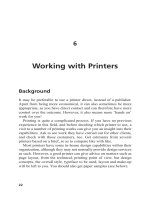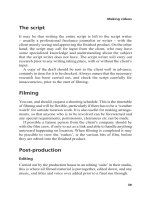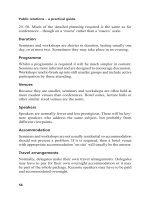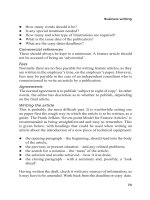Logistics fulfillment for e business a practical guide to mastering back office functions for online commerce
Bạn đang xem bản rút gọn của tài liệu. Xem và tải ngay bản đầy đủ của tài liệu tại đây (4.26 MB, 554 trang )
B Y JA N I C E R E Y N O L D S
Logistics
and
Fulfillment
FOR
e-business
A Practical Guide to Mastering
Back Office Functions for
Online Commerce
LOGISTICS & FULFILLMENT FOR E-BUSINESS
Copyright © 2001 Janice Reynolds
All rights reserved under International and Pan-American Copyright
conventions, including the right to reproduce this book or portions thereof
in any form whatsoever.
Published by CMP Books
An Imprint of CMP Media Inc.
Converging Communications Group
12 West 21 Street
New York, NY 10010
ISBN 1-57820-074-1
For individual orders, and for information on special discounts
for quantity orders, please contact:
CMP Books
6600 Silacci Way
Gilroy, CA 95020
Tel: 800-500-6875 or 408-848-3854
Fax: 408-848-5784
Email:
Distributed to the book trade in the U.S. and Canada by
Publishers Group West
1700 Fourth St., Berkeley, CA 94710
Manufactured in the United States of America
Logistics and Fulfillment for e-Business
Table of Contents
ACKNOWLEDGMENT
P R E FA C E
1
INTRODUCTION
3
C H A P T E R 1 : S E T T I N G T H E S TA G E
Defining E-business
E-business Fulfillment
You Built It, They Came — Now What?
An Unbeatable Partnership
B2B
E-Tail
For Some E-Tailers it was Easy
An In-House LFMS
Outsourcing LFM
Technology
Globalization
7
15
17
18
19
22
23
24
25
27
29
30
CHAPTER 2: MAKING THE MOVE:
E - B U S I N E S S I N F R A S T R U C T UR E
The Case for E-Business
The Other Side of the Coin
E-Business Strategy
The Logistics and Fulfillment Challenge
E-tail Model
B2B Model
Internal Operations
Technology Caveats
Adopting a Logistics and Fulfillment Model
Cardboard Boxes vs Pallets
The 3Rs and Then Some
The Time is Now
33
39
40
41
42
44
44
45
46
46
48
49
51
i
ii
Logistics and Fulfillment for e-Business
CHAPTER 3: ADOPTING A B2B MODEL
An Effective Strategy
Alternative Solutions
E-Marketplaces Might Be the Answer
The ASP Solution
The Full Monty (In-House Solution)
Why Go B2B? Revenue Growth
Manufacturing Challenges
Supply Management
Convincing the Value chain
Security
The Trickle-Down Effect
Return on Investment
The Advantages of Integration
The Right Choice
53
55
58
60
66
71
71
73
74
76
78
79
81
81
90
C H A P T E R 4 : T H E E - TA I L E R S
Lessons Learned
Is the E-Tailer an Endangered Species?
Post-Transaction Anxiety Disorder
Educate The Customer — The Reality
Click-And-Mortars
Challenges
Fulfillment
Let the Customer Do the Walking
Customer Confidence
Four Little Steps
The E-Tailers That Don’t Get It
Lessons Learned
93
94
97
99
100
102
105
106
109
110
112
113
114
C H A P T E R 5 : T H E PA R T N E R S :
O U T S O UR C I N G T H E T E C H
Tech Partnerships Are A Two-Way-Street
E-Business Start-Up Challenges
Specialization Vs. Generalization
Focus On Technology
Partner For Success
Some of the Issues
Invite That Sales Person In
117
119
123
124
125
128
129
133
Logistics and Fulfillment for e-Business
Look For Partners in all the Right Places
Stay Alert And Be Cautious
One Size Doesn’t Fit All
The Integrator or Solution Provider
Easing the Move for the Established Enterprise
Exchange Of Knowledge
Legacy Systems
Everyone Wants In On the E-Business Action
The Vendor Partnership
The Consulting Firm
A Tour of the Consultancy Arena
The Big Five
Mitigating Outsourcing Risks
The Search Begins
CHAPTER 6: SHIPPING
Your Shipping Partner?
B2B’s Shipping Needs
E-Tail’s Size & Weight Issues
E-Tail Shipping Conundrum
Shipping Vagaries Affect Sales
Shipping Options
Shipping Dilemmas
Custom Shipping Structure
“Last Mile” Solutions
Cost of Shipping
The Entrepreneur to the Rescue
Technology
Handling the Exceptions
E-Business’s Carrier Choices
Courting the USPS
UPS and Fedex
New Shipping Models
Shipping Lines (The Big Boats)
They Need It Yesterday
Thinking In The Box
Tips
134
134
135
137
145
152
154
159
161
163
164
168
174
175
177
179
181
185
189
190
191
196
199
201
202
204
207
209
213
214
216
217
218
221
223
224
iii
iv
Logistics and Fulfillment for e-Business
CHAPTER 7: LOGISTICS AND/OR FULFILLMENT MODELS 227
B2B Buy-Sell Model
231
Sell-Side Online Marketplace
232
Buy-Side Online Market
232
E-Marketplaces
233
B2B Sponsored Model
237
Manufacturer Model
239
Vendor Managed Inventory Model
244
Extended Enterprise Model
247
Direct Fulfillment Model
249
Build-To-Order/Just-In-Time Model
251
E-Tail Model
252
Pure-Play In-House Model
255
Outsourced Model
257
Drop-Ship Model
259
Click-And-Mortar
261
Local Fulfillment Model
262
Kiosk Order Model
265
Click-To-Bricks
268
Same-Day Delivery Model
270
Just-In-Time Model
273
Converged Model
276
Model of the Future?
277
C H A P T E R 8 : S T R AT E G I Z I N G A N D
PLANNING FOR AN LFMS
Logistics And Fulfillment Goals
The Questionnaire
Your LFMS Plan: What’s Involved?
3 Stages of E-Business
Security
Specificity in the LFMS Design
Customized Procurement Processes
Real-Time Procurement And Forecasting
E-Tails And Buy-Side B2Bs
Just-In-Time Logistics
Click-And-Mortar Synchronization
LFM Has “Arrived”
Links With Banks
Improved Efficiency
283
284
285
295
296
312
314
314
314
315
319
321
323
324
325
Logistics and Fulfillment for e-Business
Logistics And Fulfillment Managers
A Final Few Words
326
328
CHAPTER 9: FULFILLMENT: IN-HOUSE OR OUTSOURCE?
Meet the Challenge
Get the Tech Partners Involved
Logistics and Fulfillment Experts
Fulfillment Service Providers
Taking It In-House
Upgrading an Existing Warehouse, Distribution or Fulfillment Center
Technology Issues
Other In-House Fulfillment Considerations
Outsourcing
Some FSP Facts
Effective Fulfillment Outsourcing
The Outsourcing Plan
The Partnership
Issues Specific to a Small E-Business
How Much Does It Cost
The Contract
Technical Issues
Drop-Ship
Outsourcing Wrap-up
Returns
Solutions
The Bottom Line
331
334
339
340
342
343
344
360
362
362
364
366
369
374
375
376
376
377
380
383
384
389
399
CHAPTER 10: EXPLOITING LOGISTICS
AND FULFILLMENT TECHNOLOGY
A Balancing Act
The Big Guns — ERP
Linking ERP Systems
Working with ERP Vendors and their Partners
Best-Of-Breed Vendors
Linking the LFMS
E-Commerce Platforms
Other Software Solutions
EDI
The Languages of E-Business
HTML and HTTP
403
409
410
421
424
426
429
434
437
442
445
448
v
vi
Logistics and Fulfillment for e-Business
Java
BizTalk
XML
CPFR
An Option
Tech Musings
449
449
449
456
459
463
CHAPTER 11: IT’S ALL ABOUT THE CUSTOMER
Customer Relationships
The Internet Simplifies Life?
Managing the Customer Experience
Time - A Valuable Commodity
LFMS: Your Map to Great Customer Service
Customer Service Strategies
Keep It About the Customer
467
467
470
473
473
474
481
484
CHAPTER 12: THE 3RS GO GLOBAL
The Small E-Business Dilemma
The Servicing (Or Non-Servicing) Of The Global Customer
The Global Localization Issues
Global Logistics And Fulfillment
The Global Enablers
Global Challenges Hit the Stage Three LFMS
Traditional Customer Brokers
Global View
487
489
490
494
495
497
502
503
503
CONCLUSION
505
GLOSSARY
509
INDEX
531
Logistics and Fulfillment for E-Business
ACKNOWLEDGMENT
Acknowledgment
I MUST EXPRESS . . .
My tremendous gratitude to Phil and Nat (you know who you are) for forgoing much needed time and attention while Deborah worked with me
on this book. As always, I give much of the credit for the readability of
this book to my editor, Deborah — thank you.
I also want to thank the staff at CMP — Robbie Alterio for the wonderful cover and the speedy and artistic layout of the book; Saul Roldan who
took over from Robbie so the book could get to the printers on time.
Then, of course, many thanks go to the staff of the CMP Book Division
who have exhibited enormous patience in dealing with my peccadilloes
— Christine Kern, Lisa Giaquinto and Frank Brogan.
Special thanks also to Richard Grigonis who was always ready to lend
support and also Madeleine (this time spelled right) Delrow and Cliff
Perciavalle for always being there.
Logistics and Fulfillment for E-Business
P R E FA C E
Preface
A LT H O U G H T H E W E B H A S
quickly evolved from a
browser-based information tool to an e-business enabler, the virtual
world of e-business is increasingly blending with the realities of commerce: supply chain management, procurement, inventory management, order fulfillment and delivery of products to customers.
I’ve seen the confusion and frustration in e-business executive suites
and IT departments, especially when it comes to implementing a viable
logistics and fulfillment management system (LFMS). The necessity for
a practical logistics and fulfillment solution can’t be downplayed. The
“duct tape” systems in place today must be re-engineered for an e-business to thrive. In this day and age, failures in an e-business’s infrastructure result in problems, difficulties and outages that can not only turn
away customers, but also garner negative global media attention.
I wrote Logistics and Fulfillment for E-Business, explicitly, to guide
the non-technical executive through the ways and means of implementing an architectured infrastructure incorporating the correct tools to
achieve a fail-safe LFMS. This includes walking the reader through the
labyrinth of technical and outsourcing choices and helping them to
understand the complex and comprehensive services that good partner
relationships can provide. A robust, fail-safe LFMS is the only way for
an e-business to be successful in this new competitive landscape. A bestof-breed LFMS is not only a means for increasing customer satisfaction
1
2
Logistics and Fulfillment for E-Business
and, therefore, retention; it also introduces efficiencies and cost savings
throughout an enterprise.
If your business deals with e-businesses, is planning to adopt an ebusiness model in the near future, or is having trouble with its existing
logistics and fulfillment system — whether it’s B2B or e-tail — this book
is written for you.
— Janice Reynolds
New York, NY
Logistics and Fulfillment for E-Business
INTRODUCTION
Introduction
T H E M A J O R P O R T I O N O F e-business is logistics. The
Council of Logistics Management defines logistics as the process of planning, implementing, and controlling the efficient, effective flow and storage of goods, services, and related information from point of origin to
point of consumption for the purpose of conforming to customer
requirements.
Let’s not forget the partner of logistics, fulfillment, which also plays a
major role in many e-business models. Fulfillment comprises the backoffice systems. For e-business sites, it’s the systems that provide the link
between the customer experience and the actual physical delivery of
goods to the customer, which include inventory management, order capture and management and reconciliation.
As the year 2000 ended, several e-businesses, even pure-plays, began
to turn the corner toward profitability. For example, Boston Consulting
Group research in early 2000 indicated that about one-third of pure-play
e-tailers that have been selling online for a year or more are now making
money. And guess what, many of these stockholder-pleasing e-businesses are crediting their investment in a stable, scalable IT infrastructure
(not marketing or branding or pretty pictures) for the glad tidings.
Although there are different factors at work in the B2B arena than
there are in the e-tail area, infrastructure plays an important role in the
success of both e-business models. Two of the key factors that separate
the successful e-businesses from the failures are an efficient infrastructure and the integration of the e-business’s value chain on the back-end.
3
4
Logistics and Fulfillment for E-Business
The ascendancy of traditional bricks-and-mortar enterprises in the ebusiness community means that pure-play e-business models will have to
match the well-built back-end systems and processes that the more established enterprises already have in place. As numerous industry experts
How much is your company's Internet revenue expected to grow during the current fiscal year?
27%
10%
20%
23%
8%
12%
Base: InternetWeek 100 companies
Sources: InternetWeek, Benchmarking Partners
less than 10%
41% to 60%
10% to 20%
More than 60%
21% to 40%
Did not answer
have pointed out, logistics and fulfillment is the area where a lot of e-businesses, pure-plays in particular, fail.
What the established e-business must realize is that repeat customers
are the leading driver toward profitability. However, if an e-business is to
earn the “bookmark,” it must invest more time and resources in improving the customer experience. For many this means eliminating or reworking the processes that cause shopping cart abandonment.
Out of every ten shopping carts taken for a ride down cyber aisles, only
three make it through the checkout process. While unexpected shipping
costs or taxes put off some online shoppers, others are frustrated by logistics-and-fulfillment-related delays that slow their buying experience.
A first class LFMS could solve the problems of how to retain the customer, get the bookmark and get those overflowing shopping carts
through the checkout procedures.
What most e-businesses are unprepared for, and all e-businesses must
quickly get under control, is logistics and fulfillment management (LFM)
Introduction
— the management of the flow of goods, services and information
throughout the value chain.
The phenomenal growth of e-business brought the logistics and fulfillment issue to a head. When e-businesses first opened their sites to customers, the back-office systems could easily handle the relatively small
number of daily orders regardless of how inefficient they might have been.
But when online ordering and communications took off, mounting logistics and fulfillment problems, exacerbated by the customer’s increasing
demand for immediate delivery, resulted in chaos and disappointment.
It would appear that the shining promise of the Internet will soon be
overshadowed by the failure of many “e-preneurs” — pure-plays and
click-and-mortars, alike — whose demise will have been hastened by an
inadequate logistics and fulfillment management system (LFMS).
Running a sophisticated e-business requires management that attends to
day-to-day operations while constantly updating the business plan with input
from the value chain. Ongoing operations include managing the inventory,
packing product for shipment, coordinating the service of a shipping firm
and tracking orders until they arrive at their destination. Post-sales issues,
such as returned products, warranties and technical support, require additional functionality. An e-business must implement an LFMS in order to
establish the systems that can carry out all these functions successfully.
There are many ways in which an e-business can implement an LFMS,
but every e-business should begin with a strategy to assess its logistics and
fulfillment requirements. Then once the requirements are outlined, the ebusiness can plan the most efficient and cost-effective manner in which to
meet the requirements. This might mean entering into strategic partnerships to gain the technical, physical and staffing resources necessary, or it
could entail building an in-house solution. Alternatively, a business can
take a middle course defining what is feasible and cost-effective to handle
in-house, and outsourcing the remainder through managed partnerships.
With the proper LFMS, which can include logistics and fulfillment partner(s), any enterprise can provide the “three Rs” of e-business — the right
product at the right place at the right time. Although the Web can give ebusinesses an advantage over most traditional businesses in terms of
5
6
Logistics and Fulfillment for E-Business
product, location, and price, many e-businesses have failed to realize this
advantage. It’s as if e-businesses have forgotten that the Web is a channel
for commerce, to which most of the traditional business rules still apply,
including those of logistics and fulfillment.
The challenge of e-business is to get the product quickly and cost-effectively to the customer. If not handled carefully, poor logistics and fulfillment will prove a decisive barrier to gaining and keeping online customers. Logistics and Fulfillment for E-business is a guide to inspire nontechnical executives to discover and utilize the correct tools and/or outsourcing solutions to achieve a fail-safe LFMS (with the same enthusiasm
and energy as they embraced the Web). The technology necessary for a
world-class LFMS is dense. I have sought to provide a book that is an easy
read for the non-technical person and yet doesn’t stint on the necessary
business practices and technical issues involved in attaining the right
logistics and fulfillment solution for your e-business model.
Initiating an LFMS project with straightforward targets requires dealing
with “messyware” and a dizzying array of technical challenges.
Completion of the project on time requires careful planning, commitment
from the enterprise’s executives and staff, and a cooperative value chain.
Logistics and Fulfillment for E-business will help any e-business to
briskly apply the models of logistics and order fulfillment and adapt them
to meet their own business needs. It will give the confidence to meet the
demands of the value chain and show the steps necessary to begin to
immediately develop a viable LFMS, which, in all probability, will include
outsourcing through strategic partnerships.
Whether you’re with a small start-up business or a large enterprise, an
LFMS is both the source of competitive advantage and the lever for a positive profit margin. If you’re not good at LFM, somebody else will be. That
is the advantage that this book offers you.
Jon Ricker, president and CIO of Limited Technology Services, the technology division of The Limited Inc., (which owns Victoria’s Secret and
Victoria’s Online), makes the author’s point very clear. “You can have great
graphics, but if you don’t have a fulfillment system on the back-end to live
up to the customer’s expectations, you’re not going to get the bookmark.”
Setting the Stage
CHAPTER ONE
Setting the Stage
L O G I S T I C S A N D F U L F I L L M E N T,
o n c e considered
a dirty back-office function, has acquired a new cachet in the e-business
community. Businesses are finding that their current logistics and fulfillment infrastructures are unable to cope with the rapid growth in orders
that comes with the implementation of a top-notch Web site. The heightened expectations of the online customer must be met if an e-business is
to remain in business.
“A Web site is like an iceberg. What you see looks small and simple, but
below it you have infrastructure integration issues with may be 40 or 50
databases. So building a Web infrastructure can be a pretty serious risk
for older companies,” says Delta Air Lines CIO Charles Feld.
Kyle Shannon, co-founder and chief people officer of Agency.com, a
global Internet solutions provider, agrees. He states that the most common problem an enterprise must cope with upon adopting an e-business model is that of comprehending the impact of the move on the
enterprise. He explains that although there is certainly a technological
impact, the back-end systems that are necessary to any large enterprise
clearly need to be integrated. “That, I think, is the most obvious one,”
says Shannon.
He goes on to comment on the cultural and structural business issues
that have a dramatic impact as well. For example, in pre-Web practice a
company usually responds to customer inquiries on a two-week schedule.
On the Web, however, their online customers are probably going to
7
8
Logistics and Fulfillment for E-Business
expect a one-day or even a two-hour turnaround on their inquiries
because that’s what they get from Amazon.
“A lot of times, there is an impact in terms of how businesses are run
— what things are happening from a cultural perspective,” continues
Shannon. “Division A hasn’t talked to Division B in 40 years but on the
Internet those two divisions have to talk to one another to provide the customer with a seamless experience. So sometimes the issues are cultural,
and then sometimes they’re really more about governing. Who makes the
decision? Is the Web site an IT function, is it a marketing function, is it a
business function? Should the CEO be involved? If the CEO should be
involved, how involved should he be?”
BUSINESS MODEL
A business model integrates three activities. It formally identifies a path toward
profitability; keeps that path clear and well paved; and installs enablers along the
way to aid in the journey to the destination.
E-BUSINESS MODEL
The term “E-business Model” refers to the methodology enabling the conversion of
activities throughout an enterprise into an electronic-based system. Such a model
provides means of communication and a framework for the gathering, storing and
sharing of data that facilitates an expedient and cost-effective mode for day-to-day
business operations.The result of such methodology is a fully functional e-business,
which provides support for physical entities such as warehouses, distribution centers, stores, transportation systems, etc.
Shannon cites the need to overcome the misleading notion of the relative simplicity of transferring processes to the Web. Instead, the Web is
one of the greatest challenges an e-businesses faces. In reality this transition is quite complex, just as e-business is complex. Therefore, an
enterprise that is contemplating the adoption of an e-business model
must first lay out an e-business strategy. This usually requires bringing
in a consultant well versed in e-business models.
Setting the Stage
The Internet and the resulting economic globalization have changed
the face of business forever. Too many enterprises have made a considerable investment in developing Internet capabilities without full consideration of both the customer-centric and economic implications of their
decision. Logistics and fulfillment falls within this realm. Logistics and
fulfillment provide a structure and systems by which the e-business
(whether it’s B2B or e-tail) can:
1. Obtain the necessary product.
2. Position the product in a strategic location.
3. Offer the product at a competitive price.
4. Have the product available when needed.
5. Deliver the product to the customer at the right time.
That is the essence of an e-business logistics and fulfillment plan.
However, it takes strategizing, planning, partnerships and technology to
fulfill these five requirements.
Jane Gould of e-com-advisor.com recently interviewed Henry Bruce,
vice president of corporate marketing for Optum (www.optum.com), a
leading provider of configurable end-to-end fulfillment solutions for
pure-plays, traditional, and transitional companies — B2B and e-tail
alike. In that interview, Bruce pointed out that, “everything beyond
order entry is logistics and fulfillment. It doesn’t matter how the order
comes in — EDI, Web site, white mail, or telephone, it still requires
logistics and fulfillment processes to reach the customer.” Optum has
a star-studded list of clients including W.W. Grainger, Inc.
(www.grainger.com), the Home Shopping Network (www.hsn.com)
and Webvan.com, to name a few.
Customer questions, such as “Where is my order?,” “When can I have
it?,” “When can you deliver it?” and “If I want it tomorrow, how much will
that cost?,” have all transformed how an e-business’s value chain communicates. Everyone throughout the value chain wants to be 100% sure
that what has been stated and promised is a virtual-delivery guarantee
that can be met. However, if the front-end system is not properly integrated with the back-end system (and this holds true throughout the value
chain), you have an information disconnect. You don’t have a compre-
9
10
Logistics and Fulfillment for E-Business
hensive logistics and fulfillment management system (LFMS) in place,
and therefore, in reality, you can’t offer guaranteed delivery.
Throughout the 20th Century, businesses evolved from small familyoperated shops (usually serving a limited niche market in a small geographical area) to department stores (still serving a small geographical
area, but a larger market) to mail order catalogs (overall expansion of the
marketplace and its geographical reach). During the late decades of the
20th Century, businesses moved to expand their entire marketplace by
moving first into discount stores (using demographics to reach a different market), then into the “chain store” model (again expanding the marketplace and its geographical reach through demographics and psychographics). However, during this evolution the ability of a business model
to meet the essential components of the business remained constant.
As the 21st Century was born, a presence on the Internet had already
become a must for a business to remain competitive, moving everyone into
a global marketplace. The business community viewed the Internet as an
opportunity to establish a new global channel for commerce, and some
began to move their daily business tasks online. However, in the rush to
adopt the new e-business model, the essential components seem to have
been forgotten as three new factors worked to exert pressure on an e-business and its order fulfillment systems:
• An increasing expansion of product lines offered.
• Moving large volumes of packages at breakneck speed.
• Meeting growing value chain expectations.
The e-business model has brought with it a shift toward real-time markets that inherently changes how value chains interact. For example, with
regard to inventory management: e-businesses will soon find it’s common practice to automatically inform suppliers about what their customers are buying at any specific time, and about what isn’t moving off
the shelves. This real-time communication allows the e-business and its
supply chain to make informed decisions and react in real-time — to
adjust inventory levels, change production schedules, remove an item
from stock (if not selling), or from the Web site (if inventory is depleted).
Setting the Stage
11
“Real-time” is an adjective pertaining to computers or processes that operate in
real time versus “batch” processing. Real time describes a human rather than a
machine sense of time. Batch processing allows a program to run automatically at
a certain time without further user interaction.
For the online customer e-business means no back-orders, no out-ofstock notifications; if it’s offered for sale, it’s available.
There are many
potential pitfalls
Customers
Core Ideology
that await the business traveling the
complex path that
Strategy
is the transition to
Technology
People
e-business. Failure
to take the utmost
Process
care in constructing any one of the
sophisticated eleSuppliers
ments in the eInformation
business model can
lead the hopeful A common e-business model.
pioneer into a quagmire. Corporate culture, business process systems and technology must
be brought together. A powerful infrastructure must be erected, with the
value chain connected at the system level and the technology and
processes in place to translate data into real-time information. As if
these design tasks are not daunting enough, things really become sticky
when the multi-channel and other hybrid e-business models and submodels are brought into play. But the goal, namely, a real-time seamless
communication and sharing of data, more than justifies the effort. The
key element in the e-business model is a robust LFMS that can handle
the 3Rs across all channels simultaneously and, thereby, deliver firstclass logistics and fulfillment.
The successful e-business model requires faultless integration
12
Logistics and Fulfillment for E-Business
IMPLEMENTING LFM — A THREE STEP PROCESS
The e-business community knows it must get a handle on logistics and fulfillment.
Although most executives are confused about what it takes to implement a robust
LFMS — you can’t just go out and buy one — an LFMS is a variety of systems,
processes, technology and people that mesh together into a cohesive unit. It’s complicated and requires:
Strategy - Understand the e-business customers’ expectations and how to meet
them. Once that is well in hand, decide what the e-business wants to accomplish
with its LFMS, which requires strategizing throughout the value chain.
Planning - The strategy gives the e-business a map of what the end result should
be, but not how to go about attaining it. To do that, an e-business needs to lay
out the chain of events from procurement to receipt of the customer’s order
through delivery of the product and through the post-sale processes. It should be
a guide upon which all logistics and fulfillment decisions are based. The e-business needs to work with its value chain partners to map this logistics and fulfillment path. Then it must understand what is necessary to fulfill customer orders
in a narrow time frame and improve customer satisfaction.
Execution - Finally, the plan must be implemented in stages. This is where the
decision is made as to what solutions are needed to achieve optimum logistics
and fulfillment results — in-house, outsourcing, or others. At the same time, the
e-business will utilize technology and channels to enhance its LFMS, enabling its
value chain to share production, scheduling, inventory, forecasting and logistics
information in real-time. Customer pull (i.e., goods that are supplied to meet the
individual customer’s specification) will be the norm in most e-businesses, not
the exception.
between customer-facing applications and the supply chain so the entire
value chain knows in real-time what’s available and specific dates of
availability. This allows pre-planning by all — the suppliers, the e-business, the strategic partners, the customer and the shipping companies.
With the proper planning, the right technology and taut integration
(whether provided in-house or through partnership(s)) everyone can
avoid the potential bottlenecks lurking in procurement, credit approval,
Setting the Stage
13
inventory management, order processing or shipping. The 3Rs will
become the battle cry of the successful e-business.
End-to-end integration requires mammoth coordination between technology and the efforts of in-house IT personnel, consultants, vendors and
integrators throughout the value chain. This is a serious challenge for any
enterprise, but not insurmountable — IF there exists a clear and defined
set of goals and objectives, a proper e-business strategy with structured
T H E T H R E E S TA G E S O F E - B U S I N E S S
The most efficient, cost-effective and least disruptive way to implement an LFMS
is in three stages:
Stage One - Adoption: The e-business, although online, hasn’t optimized the procurement, movement and storage of materials and/or merchandise internally or
through its supply chain. To do this entails implementing new technology to bring
about real-time data sharing. Once the systems necessary to move into Stage One
are in place, an e-business (and its value chain) will leave behind the gridlock that
hampered productivity and negated the promised benefits that e-business was to
have wrought.
Stage Two - Automation: When an e-business is ready to move to the second
stage, it applies cutting edge logistical concepts to its processes. Eliminating
unnecessary waste brings about improved customer service through inventory
accuracy and elimination of stock-outs. The final outcome is increased sales and
lower operating costs, due to smaller inventory stock, reduction in cycle times and
smaller, decentralized distribution centers with real-time inventory control.
Stage Three - Transformation: In its race to achieve the necessary efficiencies so
that it can respond to customer pull, the e-business expands its value chain to
include additional suppliers and trading partners.There is a one-on-one relationship
throughout the value chain. Integration of Web-based supply chain tools allows the
value chain to share critical production, scheduling, inventory, forecasting and logistics information in real-time. Technology enables this process by providing a communication stream that allows value chains to collaborate in real-time, or by letting
sales reps tap into permission-based systems so they can keep customers apprised
of order status.
14
Logistics and Fulfillment for E-Business
prioritization, and proper attention to detail.
Emerson Electric Co. (www.emersonelectric.com) is well on the way.
In its chairman and CEO, Charles F. Knight’s, Letter to the Investors
giving the 1999 fiscal year report, Knight laid out a good e-business
strategy plan:
“E-Business presents many opportunities as Emerson evolves from
using the Internet as an information medium [Stage One], to
automating customer and supplier transactions [Stage Two], to ultimately transforming the way we do business [Stage Three].
“We are moving beyond the information level and focusing on higher
level applications of the Internet [i.e., Emerson is in Stage Two of its
e-business strategy plan]. For example, in our electronics business,
Liebert conducts virtually all sales transactions electronically, including product configuration, order entry and delivery update. In process
control, Fisher-Rosemount has developed an innovative site, www.testdriveplantweb.com, to communicate the substantial benefits of
PlantWeb in an intuitive and user-friendly manner that could not be
achieved through printed documents.
“In my opinion, we are just beginning to recognize the potential of
Internet technology to transform our businesses. We are moving quickly in this area, and over the next year each of our divisions will identify E-Business models to further strengthen our competitiveness.”
Emerson is making the move and doing it right. And to prove it,
Emerson Electric is the recipient of numerous awards, such as making
the year 2000 lists of: Industry Week World’s 100 Best-Managed
Companies, InternetWeek 100, eWeek Top 100 Innovators in e-Business
Networking, Fortune 500, Fortune America’s Most Admired Companies,
and Forbes Platinum 400, to name a few.
Market
E-tail
B2B
1997
1998
1999
2000
2001
2002
$2.4 B
$8 B
$8 B
$43 B
$20.2 B
$109 B
$38 B
$250 B
$64 B
$425 B
$108 B
$1.331 T
Actual and projected growth of online sales. Powerful stuff ... are you convinced?
Setting the Stage
Still hesitating? Then consider this, Forrester (www.forrester.com), a
leading independent research firm that analyzes the future of technology
and its impact, estimates that over $1.5 trillion in goods and services will
be purchased over the Web by the year 2003, with B2B commerce significantly outpacing e-tail commerce.
The complexity and cost of implementation of an LFMS is significant;
but e-businesses will soon come to realize that their customers’ satisfaction (or dissatisfaction) is explicitly linked to the performance of their
LFMS. Other benefits from an LFMS: it can enable the integration of justin-time, zero-stock inventory management and customer relationship
management initiatives into the e-business processes, allowing for a credible return on investment (ROI).
DEFINING E-BUSINESS
There is enormous confusion in the terms used to describe Internetbased business. Buzzwords abound. Although I know the following may
seem pedantic, it will help everyone to understand my usage of specific
terminology for various business models.
Many experts would agree that the standard definition of business is that
of a commercial or mercantile activity, an industrial enterprise; and that
a group of such enterprises may compose a business district. Taking this
one step further, “commerce” is one of the synonyms for “business.”
Commerce is the exchange or buying and selling of commodities on a
large scale involving transportation from place to place.
Turning to our good friend, Merriam-Webster (www.m-w.com), you
will find retail defined as “to sell in small quantities directly to the ultimate consumer.”
I use e-tail for the business-to-consumer portion of e-business. A retailer or an electronic retailer (e-tailer) sells in small quantities which presents different fulfillment needs from those of the business or commerce
provider (B2B) that buy and sell commodities on a large scale.
What I am getting at is that e-business (electronic business) and ecommerce (electronic commerce) are basically interchangeable. They
are “the [electronic] exchange or buying and selling of commodities on
15









